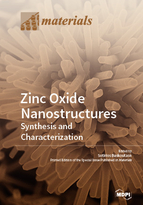Zinc Oxide Nanostructures: Synthesis and Characterization
A special issue of Materials (ISSN 1996-1944).
Deadline for manuscript submissions: closed (30 November 2017) | Viewed by 109237
Special Issue Editor
Interests: semiconductor nanostructures; optical properties; energy transfer; sensors; carbon dots from biowaste
Special Issues, Collections and Topics in MDPI journals
Special Issue Information
Dear Colleagues,
Among various metal oxide materials, ZnO presents itself as a multifunctional material due to its own properties and functionalities. The properties of ZnO include its wide band gap (3.37 eV), high exciton binding energy (60 meV), biocompatibility, ease of fabrication and so on. Due to its excellent properties, ZnO is widely used for various potential applications such as catalysis, solar cells, ultraviolet (UV) lasers, light emitting diodes, photo-detectors, sensors (chemical, bio- and gas), optical and electrical devices and so on. Among various applications, the use of ZnO nanomaterials as a photocatalyst has particular interest due to their large surface area; wide band gap; ease of fabrication and cost effective synthesis; biocompatible and environmentally benign nature.
More specifically, the nanostructured ZnO semiconductor used as photocatalytic degradation material against environmental pollutants has also been extensively studied, because of its advantages of non-toxic nature, low cost and high reactivity. However, such a photocatalytic degradation only proceeds under UV irradiation because this semiconductor can only absorb UV light. Therefore, ZnO-based materials capable of visible-light photocatalysis are required.
Furthermore, the synthesis of large-scale arrayed 1D ZnO nanostructures, including nanowires, nanorods, nanobelts and whiskers, is an important step for the fabrication of functional nano/microdevices. Recently, because of its high-temperature strength and rigidity, as well as excellent chemical stability, small-diameter ZnO whiskers have received great attention for industrial applications as reinforcement phase in composite materials. ZnO whiskers with high aspect ratio have also been successfully used as a probing tip to develop new precise high-resolution imaging techniques for atomic force microscopy and scanning tunneling microscopy.
Finally, Magnetic ion-doped ZnO quantum dots (QDs) have been targeted as promising candidates for the implementation of novel technologies, such as in spintronic and quantum computation.
Prof. Sotirios Baskoutas
Guest Editor
Manuscript Submission Information
Manuscripts should be submitted online at www.mdpi.com by registering and logging in to this website. Once you are registered, click here to go to the submission form. Manuscripts can be submitted until the deadline. All submissions that pass pre-check are peer-reviewed. Accepted papers will be published continuously in the journal (as soon as accepted) and will be listed together on the special issue website. Research articles, review articles as well as short communications are invited. For planned papers, a title and short abstract (about 100 words) can be sent to the Editorial Office for announcement on this website.
Submitted manuscripts should not have been published previously, nor be under consideration for publication elsewhere (except conference proceedings papers). All manuscripts are thoroughly refereed through a single-blind peer-review process. A guide for authors and other relevant information for submission of manuscripts is available on the Instructions for Authors page. Materials is an international peer-reviewed open access semimonthly journal published by MDPI.
Please visit the Instructions for Authors page before submitting a manuscript. The Article Processing Charge (APC) for publication in this open access journal is 2600 CHF (Swiss Francs). Submitted papers should be well formatted and use good English. Authors may use MDPI's English editing service prior to publication or during author revisions.
Keywords
- ZnO nanostructures
- electronic properties
- synthesis
- characterization
- sensors
- optoelectronics
- excitons
- fine structure splitting
- quantum computation
- photon entanglement







